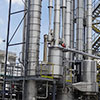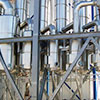Falling Film Evaporator
Falling film evaporators are vertical shell and tube type evaporators, in which the product flows inside the tubes and the steam through the shellside, heating the external wall of the tubes.
The liquid enters through the upper part of the evaporator effect and falls by gravity evenly through the tubes forming a thin layer of product, heated by direct contact with the interior wall. In falling film evaporators the product passes through the tubes of one effect and then is transferred to the next until it reaches the last one and exits the concentrator.
Most liquids usually decrease their viscosity at higher temperatures, which allows in higher falling speeds resulting in a equipment operating with short residence times, an important factor when concentrating heat sensitive products. This property is used to determine the correct flow of the product between the evaporator effects and in some cases it is convenient to use the highest temperature effect (usually the first) to concentrate the highest solids content product in order to increase its flow, generating better heat transfer coefficients due to the lower viscosity at high temperatures. The high product circulation speeds achieved in falling film evaporators allow to respond quickly to changes in operating conditions and reduce start-up and shutdown times.
In falling film concentrators, the product layer formed inside the tubes must be thin enough to allow high heat transfer coefficients, but thick enough to avoid fouling and latter burning of the product. In some arrangements, depending on the product and application, the liquid must be recirculated to the same effect by means of high flow rate pumps to increase heat transfer coefficients even more due to high turbulence of the product and improve tube loading, avoiding fouling and burning.
To prevent this, the design of the distributor at the top of each evaporator effect is a critical and essential issue for the adequate performance of the concentrator and a resulting product of optimal quality. This is combined with the use of long evaporation tubes, up to 13 meters long (around 39 feet), increasing the liquid flow through each tube, given that the same heating surface can be achieved with less amount of tubes thanks to their increased length..
The falling film evaporator also operates with low thermal differentials due to the high heat transfer coefficients achieved. This is particularly important when designing multiple effect evaporators, because a low heat transfer coefficient would result in larger heat transfer areas, increasing the equipment size and cost.
Main Features
- High heat transfer coefficients
- Low thermal differentials
- Short residence times
- Quick response to operating conditions
- Short start-up and shutdown times




